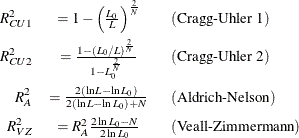The MDC Procedure
McFadden (1974) suggests a likelihood ratio index that is analogous to the R-square in the linear regression model:
where ![]() is the maximum of the log-likelihood function and
is the maximum of the log-likelihood function and ![]() is the maximum of the log-likelihood function when all coefficients, except for an intercept term, are zero. McFadden’s likelihood
ratio index is bounded by 0 and 1.
is the maximum of the log-likelihood function when all coefficients, except for an intercept term, are zero. McFadden’s likelihood
ratio index is bounded by 0 and 1.
Estrella (1998) proposes the following requirements for a goodness-of-fit measure to be desirable in discrete choice modeling:
-
The measure must take values in
![$[0,1]$](images/etsug_mdc0191.png) , where 0 represents no fit and 1 corresponds to perfect fit.
, where 0 represents no fit and 1 corresponds to perfect fit.
-
The measure should be directly related to the valid test statistic for the significance of all slope coefficients.
-
The derivative of the measure with respect to the test statistic should comply with corresponding derivatives in a linear regression.
Estrella’s measure is written as
Estrella suggests an alternative measure,
where ![]() is computed with null parameter values,
is computed with null parameter values, ![]() is the number of observations used, and
is the number of observations used, and ![]() represents the number of estimated parameters.
represents the number of estimated parameters.
Other goodness-of-fit measures are summarized as follows:

The AIC and SBC are computed as follows:
where ![]() is the log-likelihood value for the model, k is the number of parameters estimated, and n is the number of observations (that is, the number of respondents).
is the log-likelihood value for the model, k is the number of parameters estimated, and n is the number of observations (that is, the number of respondents).